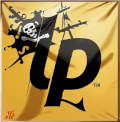Worth noting that paying for a license for software doesn't stop it being spying malware either. In fact the pirate versions often take out the spying and the reporting-to-homebase that proprietary software does.
The photoshop that phones home to check a license is arguably more malicious than the pirate version that has been cracked so it doesn't do that.


